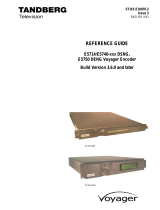Chapter 1: Introduction
2
The IF signals delivered by the down-converters are fed into the rack-mount
demodulator, which demodulates them using the MRC diversity technique
and then decodes them to obtain two composite video signals, two SDI
digital signals, four analogue audio signals and four digital audio signals
embedded in the SDI signal. All models of the DR-100 series also have a
DVB-ASI transport stream output that can be extremely useful if several
decoders are to be chained or to implement an intermediate ASI feed
without having to decode it. They also have a Genlock reference input in
order to lock the SDI output signals.
This equipment is capable to receive GPS data or other data types
introduced, at different speeds, in the data channel in SVP transmitters.
The display and the keypad on the front panel of the demodulator
equipment can be used to monitor many parameters of interest, such as the
modulation, the Viterbi coding or the FEC, and the guard interval used
(obtained when the TPS, [Transmission Parameter Signalling] carriers are
demodulated), signal levels, link quality parameters such as the SNR, the
MER and the BER and the presence of alarms and/or warnings.
When steering the antennas, the main screen showing the signal levels and
the SNR of the IF inputs is very helpful. These measurements are displayed
as a bar graph and as numerical values. The numerical values do not
express signal levels or SNR in dB, they are merely indicative. The scale for
the signal levels is from 1 to 100, and the SNR values range from 1 to 10.
These measurements are really useful while orienting the antennas.
There is also a UDP/IP Ethernet link that allows these and many other
parameters to be controlled and monitored from a remote station.
The equipment can be AC mains powered or run off DC batteries. The
switchover from the mains to batteries is automatic. The down-converters
are powered from the demodulator unit via the IF coaxial cable that
connects them together.
The Down-Converters are waterproof and are installed next to the reception
antennas.
An optional flight case is available for the rack-mount demodulator. Its size
is 2 units rack; consequently, two equipments can be transported in it.
Figure 1.2 A flight case for the rack-mount demodulator


























